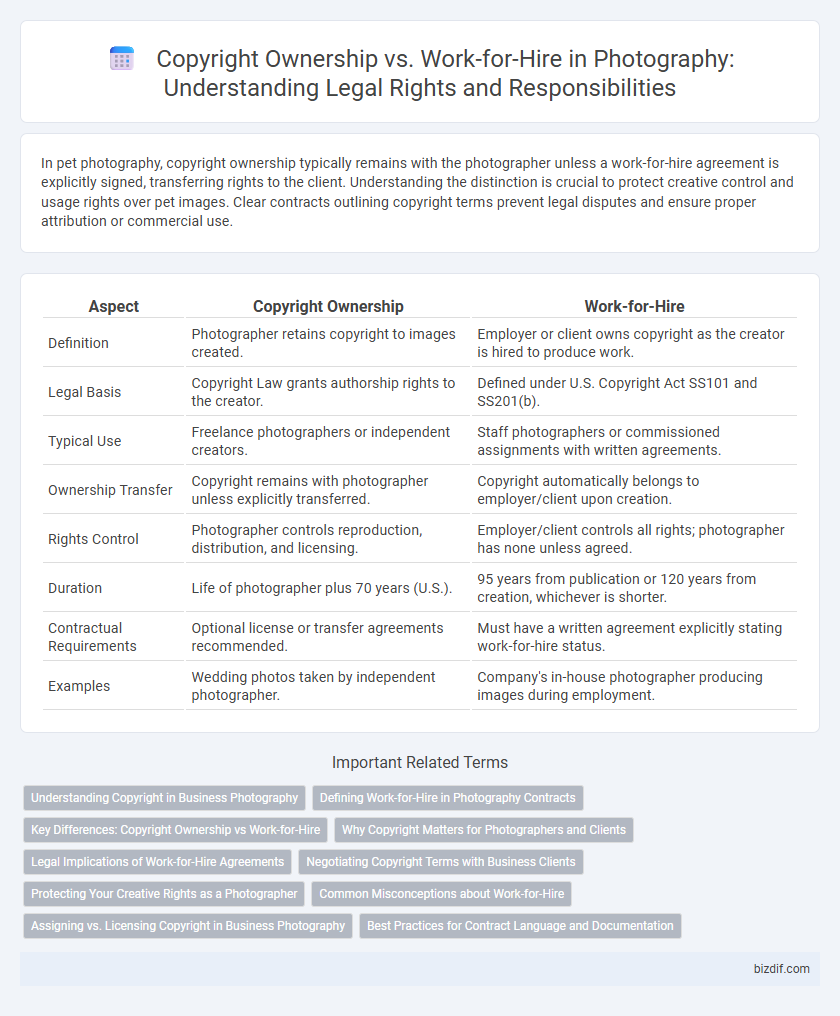In pet photography, copyright ownership typically remains with the photographer unless a work-for-hire agreement is explicitly signed, transferring rights to the client. Understanding the distinction is crucial to protect creative control and usage rights over pet images. Clear contracts outlining copyright terms prevent legal disputes and ensure proper attribution or commercial use.
Table of Comparison
| Aspect | Copyright Ownership | Work-for-Hire |
|---|---|---|
| Definition | Photographer retains copyright to images created. | Employer or client owns copyright as the creator is hired to produce work. |
| Legal Basis | Copyright Law grants authorship rights to the creator. | Defined under U.S. Copyright Act SS101 and SS201(b). |
| Typical Use | Freelance photographers or independent creators. | Staff photographers or commissioned assignments with written agreements. |
| Ownership Transfer | Copyright remains with photographer unless explicitly transferred. | Copyright automatically belongs to employer/client upon creation. |
| Rights Control | Photographer controls reproduction, distribution, and licensing. | Employer/client controls all rights; photographer has none unless agreed. |
| Duration | Life of photographer plus 70 years (U.S.). | 95 years from publication or 120 years from creation, whichever is shorter. |
| Contractual Requirements | Optional license or transfer agreements recommended. | Must have a written agreement explicitly stating work-for-hire status. |
| Examples | Wedding photos taken by independent photographer. | Company's in-house photographer producing images during employment. |
Understanding Copyright in Business Photography
In business photography, copyright ownership determines who holds the exclusive rights to use and distribute the images, typically the photographer unless a work-for-hire agreement applies. Under work-for-hire terms, clients commissioning the photos may legally own the copyright, enabling full control over reproduction and licensing. Understanding these distinctions is crucial for photographers to protect their intellectual property and for businesses to secure proper usage rights.
Defining Work-for-Hire in Photography Contracts
Work-for-hire in photography contracts refers to an arrangement where the photographer's creative output is legally owned by the client or commissioning party rather than the photographer. This legal framework ensures that the client holds the copyright from the moment of creation, typically requiring explicit written agreements that specify the work-for-hire status. Understanding the distinction between copyright ownership and work-for-hire is essential for photographers to protect their intellectual property rights and negotiate clear contract terms.
Key Differences: Copyright Ownership vs Work-for-Hire
Copyright ownership grants the photographer exclusive rights to reproduce, distribute, and display their original work, while work-for-hire agreements transfer these rights to the commissioning party upon creation. In a work-for-hire, the commissioning entity is considered the legal author, often employed in commercial or corporate photography settings. Understanding these distinctions is critical for photographers to protect their intellectual property and negotiate fair contracts.
Why Copyright Matters for Photographers and Clients
Copyright ownership grants photographers exclusive rights to reproduce, distribute, and license their images, ensuring control over how their creative work is used and monetized. In work-for-hire agreements, clients own the copyright, which impacts photographers' ability to showcase or sell their photos independently. Understanding copyright distinctions protects photographers' financial interests and clients' usage rights, preventing legal disputes and fostering clear creative collaboration.
Legal Implications of Work-for-Hire Agreements
Work-for-hire agreements in photography transfer copyright ownership directly to the employer or client, meaning the photographer does not retain rights to the images produced. Without clear contractual terms, photographers risk losing control over usage, reproduction, and licensing of their work. Understanding and negotiating these legal implications is crucial to protect creative and economic interests in professional photography contracts.
Negotiating Copyright Terms with Business Clients
Negotiating copyright terms with business clients requires clear agreements that specify whether the photography work is considered a work-for-hire or if copyright ownership remains with the photographer. Precise contract language should outline usage rights, licensing scope, and duration to prevent disputes over image control and monetization. Establishing these terms upfront enhances professional relationships and safeguards both the photographer's intellectual property and the client's commercial interests.
Protecting Your Creative Rights as a Photographer
Photographers retain copyright ownership of their images unless a clear work-for-hire agreement assigns rights to the client, making it crucial to establish contracts that explicitly state ownership terms. Registering copyrights and including usage licenses in agreements safeguard creative rights and provide legal recourse against unauthorized use. Understanding the distinction between copyright ownership and work-for-hire status empowers photographers to protect their intellectual property and maximize control over their creative work.
Common Misconceptions about Work-for-Hire
Many photographers mistakenly believe that all images created during employment automatically become the property of the employer, but copyright laws specify strict criteria for work-for-hire classification. Work-for-hire applies only when a photographer is explicitly commissioned under a written agreement or is a direct employee working within job scope, otherwise, copyright remains with the creator. Understanding the nuances between independent contractor status and employee roles is essential for protecting photographer rights and ensuring proper copyright ownership.
Assigning vs. Licensing Copyright in Business Photography
In business photography, assigning copyright transfers full ownership from the photographer to the client, granting the client exclusive rights to use, modify, and distribute the images without further permissions. Licensing copyright allows the photographer to retain ownership while granting the client limited, defined rights to use the photos under specific terms and durations. Understanding the distinction between assignment and licensing is crucial for photographers and businesses to protect their intellectual property and avoid potential legal disputes.
Best Practices for Contract Language and Documentation
Clear contract language specifying whether a photography project is considered work-for-hire or involves transfer of copyright ownership is essential to protect both parties' rights. Detailed documentation should include explicit clauses on copyright assignment, usage rights, and payment terms to avoid disputes and ensure legal clarity. Consistently using standardized contract templates and obtaining written agreement before beginning any project reinforces enforceable copyright terms in professional photography engagements.
Copyright Ownership vs Work-for-Hire Infographic

 bizdif.com
bizdif.com